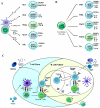Role of T Follicular Helper Cells in Viral Infections and Vaccine Design
- PMID: 40214462
- PMCID: PMC11987902
- DOI: 10.3390/cells14070508
Role of T Follicular Helper Cells in Viral Infections and Vaccine Design
Abstract
T follicular helper (Tfh) cells are a specialized subset of CD4+ T lymphocytes that are essential for the development of long-lasting humoral immunity. Tfh cells facilitate B lymphocyte maturation, promote germinal center formation, and drive high-affinity antibody production. Our current knowledge of Tfh interactions with the humoral immune system effectors suggests that they have a critical role in supporting the immune response against viral infections. This review discusses the mechanisms through which Tfh cells influence anti-viral immunity, highlighting their interactions with B cells and their impact on antibody quality and quantity. We explore the role of Tfh cells in viral infections and examine how vaccine design can be improved to enhance Tfh cell responses. Innovative vaccine platforms, such as mRNA vaccines and self-assembling protein nanoplatforms (SAPNs), are promising strategies to enhance Tfh cell activation. Their integration and synergistic combination could further enhance immunity and Tfh responses (SAPN-RNA vaccines). In summary, we provide a comprehensive overview of the current insights into Tfh cells' role during viral infections, emphasizing their potential as strategic targets for innovative vaccine development.
Keywords: B cells; Tfh cells; ferritin; germinal centers; mRNA vaccine; viral infections.
Conflict of interest statement
The authors declare no conflicts of interest.
Figures



Similar articles
-
Early T Follicular Helper Cell Responses and Germinal Center Reactions Are Associated with Viremia Control in Immunized Rhesus Macaques.J Virol. 2019 Feb 5;93(4):e01687-18. doi: 10.1128/JVI.01687-18. Print 2019 Feb 15. J Virol. 2019. PMID: 30463978 Free PMC article.
-
Viral Replicative Capacity, Antigen Availability via Hematogenous Spread, and High TFH:TFR Ratios Drive Induction of Potent Neutralizing Antibody Responses.J Virol. 2019 Mar 5;93(6):e01795-18. doi: 10.1128/JVI.01795-18. Print 2019 Mar 15. J Virol. 2019. PMID: 30626686 Free PMC article.
-
Crucial roles of interleukin-7 in the development of T follicular helper cells and in the induction of humoral immunity.J Virol. 2014 Aug;88(16):8998-9009. doi: 10.1128/JVI.00534-14. Epub 2014 Jun 4. J Virol. 2014. PMID: 24899182 Free PMC article.
-
T Follicular Helper Cell Heterogeneity.Annu Rev Immunol. 2024 Jun;42(1):127-152. doi: 10.1146/annurev-immunol-090222-102834. Epub 2024 Jun 14. Annu Rev Immunol. 2024. PMID: 38060987 Review.
-
The Janus Face of Follicular T Helper Cells in Chronic Viral Infections.Front Immunol. 2018 May 25;9:1162. doi: 10.3389/fimmu.2018.01162. eCollection 2018. Front Immunol. 2018. PMID: 29887868 Free PMC article. Review.
Cited by
-
Innovation in mRNA Vaccines and RNAi via Protein Nanocages.Vaccines (Basel). 2025 Jun 18;13(6):653. doi: 10.3390/vaccines13060653. Vaccines (Basel). 2025. PMID: 40573984 Free PMC article. Review.
-
Biosecurity and Vaccines for Emerging Aquatic Animal RNA Viruses.Viruses. 2025 May 28;17(6):768. doi: 10.3390/v17060768. Viruses. 2025. PMID: 40573359 Free PMC article. Review.
References
-
- Murphy F.A. Epidemiology of Human and Animal Viral Diseases. Encycl. Virol. 2008:140–148. doi: 10.1016/B978-012374410-4.00390-3. - DOI
Publication types
MeSH terms
LinkOut - more resources
Full Text Sources
Medical
Research Materials

